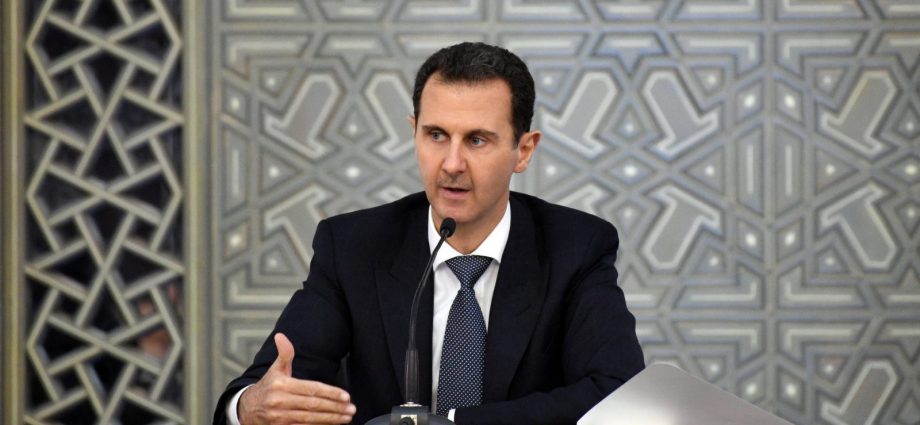
The gentle footsteps of normalization with the Syrian government have become considerably faster since the devastating earthquakes at the start of this month.
President Bashar al-Assad, for so long diplomatically confined to Damascus, first visited Oman. This week, there was a giant leap, as Egypt’s foreign minister landed in Damascus for further post-earthquake diplomacy.
It’s not exactly that too much water has passed under the bridge between the two countries; more that simply too much politics has happened for too long.
The February earthquakes that devastated parts of Turkey and Syria were something of a turning point for relations between Middle Eastern regimes and Damascus.
To get a sense of how long it has been that Assad has been outside of the Middle Eastern fold, consider that his phone call on February 7 – the day after the earthquakes – with Egyptian President Abdel Fattah el-Sisi was his first ever conversation with Sisi.
Since Mohamed Morsi, Egypt’s short-lived Islamist president, formally cut diplomatic ties with the Assad regime in 2013, the country has had two further presidents, neither of whom had spoken to Assad. (For those wondering, Morsi’s successor was Adly Mansour, interim president before the 2014 election.)
This growing wave of normalization so many years after the region froze out Assad over his widespread crackdown on Arab Spring protests also has lessons for other parts of the world. In particular it has lessons for the Ukraine war, a year into the Russian invasion, as the West and major countries such as China and India begin to grapple with the reality that Ukraine might become a forever war.
As policymakers and analysts wrestle with the consequences and potential direction of the Ukrainian conflict, they should look closely at what is happening with the Syrian regime and its neighbors. Because the normalization is really a reflection of the length of time that the Syrian conflict has continued unresolved.
A conflict on the scale of the Syrian war has vast external consequences. Mass movements of people, disruption to trade, armed militias, to name just a few, have immense knock-on impacts on the politics, economics and social order of countries far beyond the conflict.
Because of the sheer scale of the war and the problems it generates, it can be tempting to freeze the conflict, to deal only with the externalities like refugees or border skirmishes, and leave the rest to a future date.
But these conflicts are forever at the mercy of events, both political and, as we have seen with the earthquake, natural. The longer conflicts on this scale continue, the more likely it is that something happens which changes the calculations of politicians in countries in the region and beyond.
This is exactly what is likely to happen with the Ukraine conflict, which, a year on, is in danger of becoming a forever war.
Both sides appear determined to escalate: The Russians are in the midst of the new offensive, and the West is preparing to supply Ukraine with new weaponry including tanks, and perhaps even fighter jets. All of which means there is unlikely to be any way out of this conflict soon.
The possibility that either side might achieve a comprehensive victory is slim; what both Kiev and Moscow are seeking, as Russian President Vladimir Putin himself suggested in his anniversary speech, is the “strategic defeat” of the other.
From Russia’s perspective, a forever, frozen war in Ukraine is a solution that Moscow can live with. The conflict in Crimea was in essence frozen for years until 2022, and Russia’s 2008 invasion of Georgia similarly stuck.
These frozen conflicts benefit the aggressor, because they remove the momentum from their opponents and rely heavily on other political events to distract supporters. Eventually, unexpected events show up, all of which pressure other countries to find a solution, however imperfect.
This is how the march toward normalization began in Syria. Unexpected consequences gradually began to appear: the immense stress that neighboring countries like Jordan and Lebanon were subjected to; the combination of a worsening Turkish economy and a social backlash against so many Syrian immigrants; the opportunity that Iran seized to interfere further in Syria. All of these convinced Syria’s neighbors that normalization was better than an endless, frozen conflict.
The same thing is happening in Ukraine, where calculations have gradually shifted in a year of conflict. And not solely against Russia. China is an example of how unexpected events can change perceptions.
A year ago, Beijing may have been content with a lightning Russian victory or even a Ukrainian pushback that left Russia weakened and more dependent on China. But now Beijing’s calculations have shifted.
So tenacious has Ukrainian resistance been that China is now concerned what message a Russian loss might send to Taiwan. Might the Taiwanese look across the strait and think that they too might have a chance against the much larger and better-armed People’s Liberation Army?
The worst thing for the rest of the world would be for Ukraine’s conflict to be frozen. All the momentum and Western support would fade away. As happened in Syria, politics would continue elsewhere until something – a war, an earthquake, something unexpected – pierced the ice.
Then, just as earthquake diplomacy is causing a rethink throughout the Middle East, the Ukraine conflict would need to be rapidly and suddenly unfrozen.
This article was provided by Syndication Bureau, which holds copyright.
Faisal Al Yafai is currently writing a book on the Middle East and is a frequent commentator on international TV news networks. He has worked for news outlets such as The Guardian and the BBC, and reported on the Middle East, Eastern Europe, Asia and Africa. Follow him on Twitter @FaisalAlYafai.

